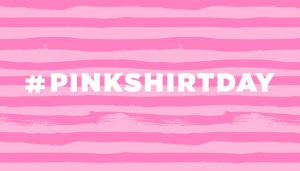Pink Shirt Day is upon us! Today we come together globally to take a stand against bullying, both in life and online, and spread awareness and raise funds for childrens programs focused on treating depression, low self-esteem, anxiety and, physical and emotional trauma.
Pink Shirt Days humble beginnings started in Nova Scotia, Canada in 2007 when two high school students, David Shepherd and Travis Price came together to support a new student who was being bullied for wearing a pink shirt. they organized immediately and purchased 50 pink tank tops to hand out to other boys in the school the next day.

The message was clear, they were not going to tolerate bullying. Since them a world wide movement began. After David and Travis’ act of kindness in 2007, CKNW Orphans Fund (https://www.cknworphansfund.com) was inspired to help other youth affected by bullying, with many staff members wearing pink shirts and collecting funds to support Boys and Girls Clubs. Since then, the idea has only grown each year, with worldwide support and participation. Countries across the globe are now organizing anti-bullying fundraisers of their own, including Japan, New Zealand, China, Panama, and numerous others. In fact, last year alone, people in almost 180 countries shared their support of Pink Shirt Day through social media posts and donations.

Coast Capital (https://www.coastcapitalsavings.com/) is donating $1 in support of bullying prevention programs for youth in BC. All you have to do is say something nice about someone on Instagram, Facebook or Twitter and add #PinkItForward!

So, what is bullying? TYPES OF BULLYING
- Physical bullying: using physical force or aggression against another person (e.g., hitting)
- Verbal bullying: using words to verbally attack someone (e.g., name-calling)
- Social/relational bullying: trying to hurt someone through excluding them, spreading rumours or ignoring them (e.g., gossiping)
- Cyberbullying: using electronic media to threaten, embarrass, intimidate, or exclude someone, or to damage their reputation (e.g., sending threatening text messages).
BULLYING VS HARASSMENT, Bullying and harassment are similar, yet different:
- Harassment is similar to bullying because someone hurts another person through cruel, offensive and insulting behaviours.
- Harassment is different from bullying in that it is a form of discrimination.
WHAT IS DISCRIMINATION? Discrimination is treating someone differently or poorly based on certain characteristics or differences. Bullying turns into harassment when the behaviour goes against Canada’s Human Rights Laws and focuses on treating people differently because of:
- Age
- Race (skin colour, facial features)
- Ethnicity (culture, where they live, how they live, how they dress)
- Religion (religious beliefs)
- Sex Sexual orientation (if they are gay, lesbian, bisexual, or heterosexual)
- Family status (if they are from a single parent family, adopted family, step family, foster family, non-biological gay or lesbian parent family)
- Marital status (if they are single, legally married, common-law spouse, widowed, or divorced)
- Physical and mental disability (if they have a mental illness, learning disability, use a wheelchair)
Take a Stand with Max today!
Follow us, share and like more content we put out almost daily on Facebook, Instagram and Twitter! Never miss a moment with Max Agency!
For more of our awesome talent check out our roster at http://www.maxagency.com/
If you want to become one of our talent, apply here! http://www.maxagency.com/application.php

